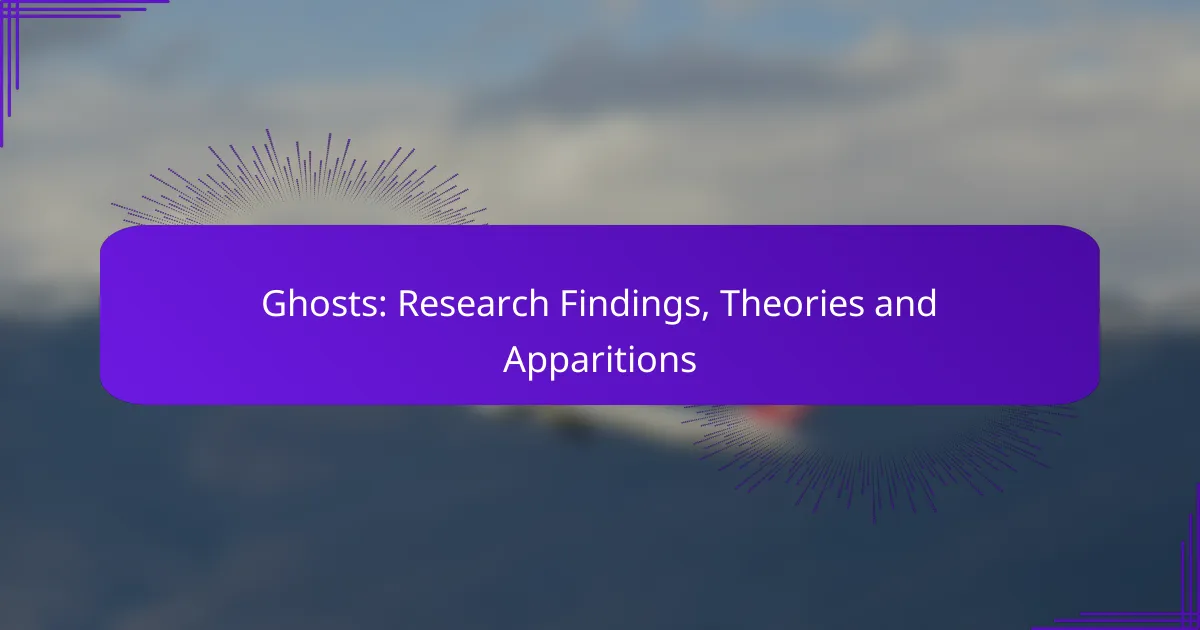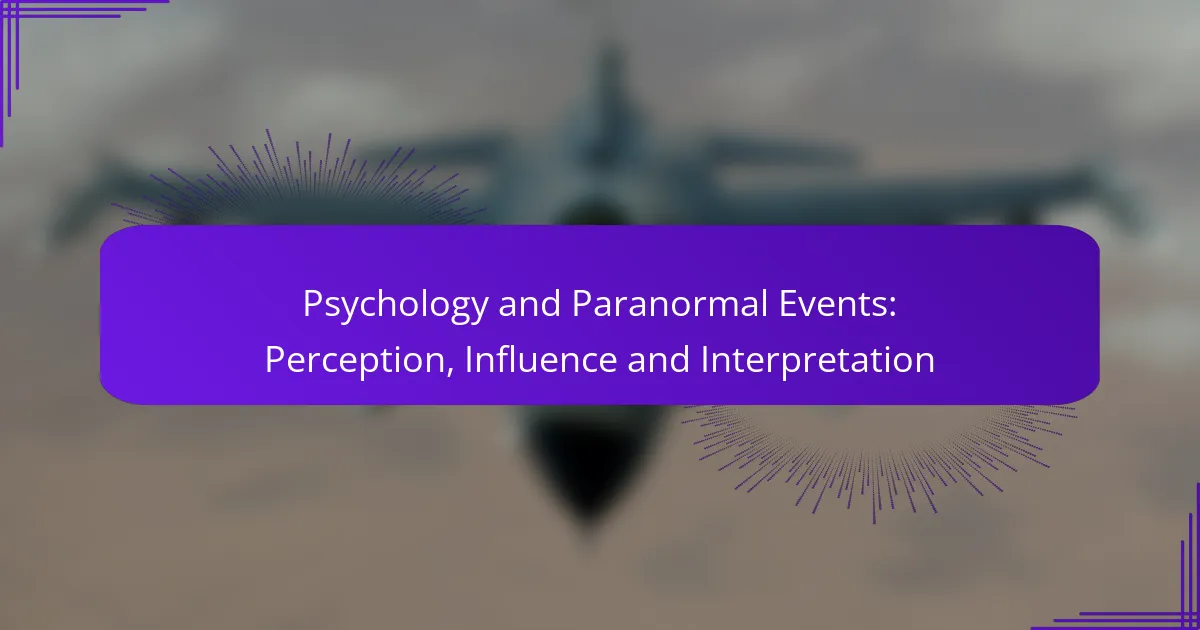Poltergeist activity is a fascinating phenomenon often linked to psychological, emotional, and environmental factors, manifesting through unexplained noises and moving objects. Recognizing the specific characteristics of these disturbances can help differentiate them from other types of paranormal events. The impact of poltergeist activity can be profound, inducing fear and anxiety that affect individuals’ daily lives and relationships.
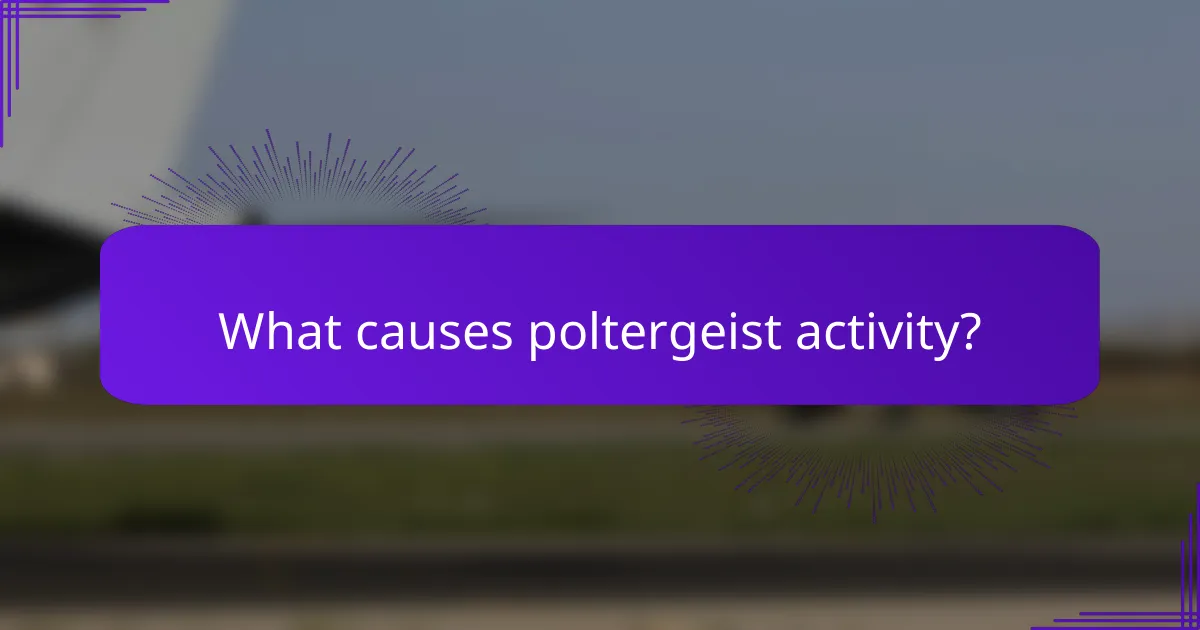
What causes poltergeist activity?
Poltergeist activity is often attributed to a combination of psychological, environmental, and emotional factors. These disturbances typically manifest as unexplained noises, moving objects, and other phenomena, often linked to individuals experiencing significant stress or emotional upheaval.
Emotional disturbances
Emotional disturbances are frequently considered a primary trigger for poltergeist activity. Individuals undergoing intense emotional stress, such as grief, anger, or anxiety, may inadvertently manifest this energy in the form of physical disturbances. For example, a teenager experiencing turmoil might unintentionally cause objects to move or create noises in their environment.
Understanding the emotional state of those involved can provide insight into the nature of the disturbances. Keeping a journal of emotional fluctuations alongside reported poltergeist activity can help identify patterns and potential connections.
Environmental factors
Environmental factors play a significant role in poltergeist activity, with certain locations more prone to disturbances. Areas with high levels of humidity, temperature fluctuations, or structural issues may contribute to the phenomenon. For instance, old buildings with creaky floors and drafty windows can create eerie sounds that might be misinterpreted as paranormal activity.
Additionally, cluttered spaces can amplify feelings of unease, making individuals more susceptible to perceiving disturbances. Maintaining a clean and organized environment can help reduce anxiety and the likelihood of misinterpreting normal sounds as supernatural occurrences.
Psychokinetic energy
Psychokinetic energy, or the ability to influence physical objects with the mind, is often linked to poltergeist activity. This energy is believed to be generated by individuals, particularly adolescents, during times of emotional upheaval. The theory suggests that strong emotions can create a form of energy that manifests as physical disturbances.
To explore this concept, individuals experiencing poltergeist activity might consider practicing mindfulness or relaxation techniques. Reducing stress can help minimize the potential for psychokinetic manifestations.
Historical trauma
Historical trauma in a location can contribute to poltergeist activity, as unresolved emotional pain may linger in the environment. Sites with a history of violence, tragedy, or significant emotional events can become charged with residual energy, leading to disturbances. For example, a home built on land with a tragic past may experience heightened activity.
Researching the history of a location can provide context for the disturbances. Engaging in rituals or discussions to acknowledge and honor past events may help alleviate some of the negative energy associated with the site.
Electromagnetic fields
Electromagnetic fields (EMFs) have been studied for their potential connection to poltergeist activity. High levels of EMFs, often produced by electrical appliances or wiring issues, can cause feelings of unease, anxiety, and even hallucinations in sensitive individuals. This can lead to the misinterpretation of normal occurrences as paranormal events.
To mitigate the effects of EMFs, individuals can use EMF meters to identify sources of high electromagnetic activity in their environment. Reducing exposure by relocating appliances or using EMF shielding can help create a more comfortable living space.

How can you identify poltergeist activity?
Poltergeist activity can be identified through specific signs, including unexplained noises, moving objects, temperature fluctuations, and electronic disturbances. Recognizing these characteristics can help differentiate poltergeist phenomena from other types of disturbances.
Unexplained noises
Unexplained noises are a common indicator of poltergeist activity. These sounds can range from loud bangs and knocks to soft whispers or footsteps, often occurring when no one is present. Pay attention to the timing and frequency of these noises, as they may correlate with other unusual occurrences.
To investigate, consider documenting the sounds with audio recordings or notes on when and where they happen. This can help establish patterns and provide evidence if you seek assistance from paranormal investigators.
Moving objects
Objects that move on their own are a hallmark of poltergeist activity. This can include items being thrown, shifted, or even levitating without any visible cause. Common examples are books falling off shelves or furniture being rearranged.
When observing moving objects, ensure that there are no logical explanations, such as drafts or vibrations from nearby traffic. Documenting the incidents with photographs or videos can be useful for further analysis.
Temperature fluctuations
Sudden temperature changes in a space can indicate poltergeist activity. These fluctuations may manifest as cold spots or areas that feel unusually warm. Such changes often occur without any apparent reason, making them noteworthy.
To assess temperature variations, use a thermometer to track changes over time. Noting the locations and times of these fluctuations can help identify potential patterns associated with the activity.
Electronic disturbances
Poltergeist activity can also disrupt electronic devices. This may include flickering lights, malfunctioning appliances, or unexplained battery drain. Such disturbances can create an unsettling atmosphere and may coincide with other signs of paranormal activity.
To investigate electronic disturbances, monitor devices for unusual behavior and consider using surge protectors or uninterruptible power supplies to mitigate issues. Documenting these occurrences can provide valuable insights into the nature of the disturbances.
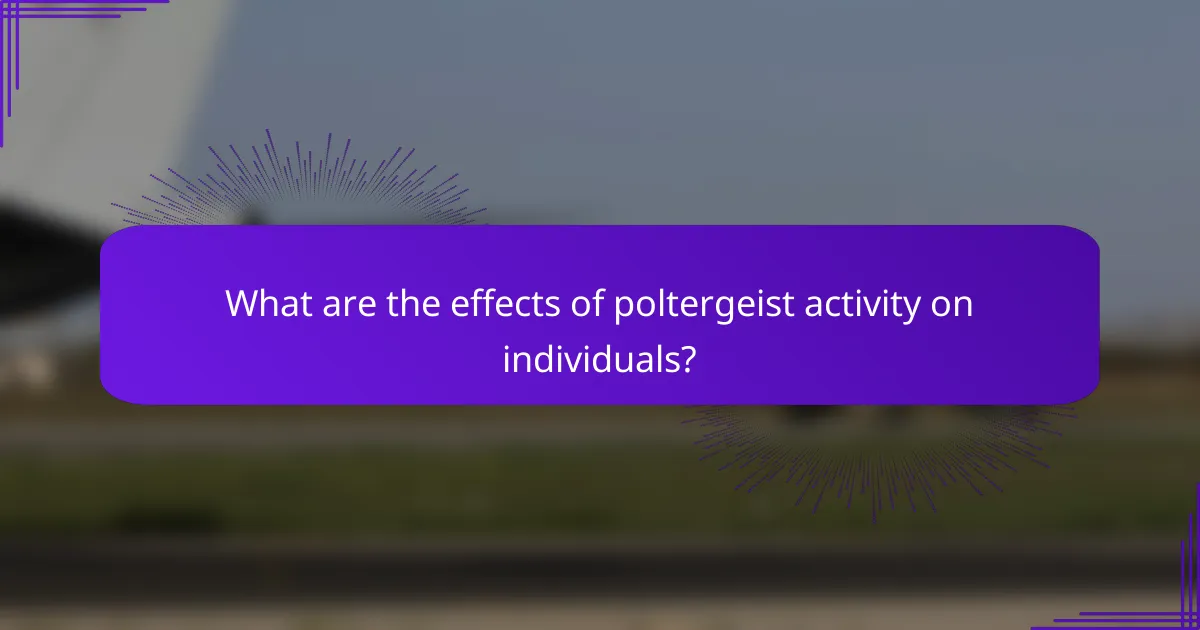
What are the effects of poltergeist activity on individuals?
Poltergeist activity can significantly impact individuals, leading to a range of psychological, physical, and social effects. These disturbances often create an atmosphere of fear and anxiety, which can affect daily life and relationships.
Psychological stress
Individuals experiencing poltergeist activity often report heightened levels of psychological stress. This stress can manifest as anxiety, fear, and even depression, as the unpredictability of the disturbances creates a constant state of unease.
Common symptoms include insomnia, irritability, and difficulty concentrating. The mental toll can be exacerbated if individuals feel isolated in their experiences, leading to a cycle of increased stress and emotional turmoil.
Physical disturbances
Physical disturbances associated with poltergeist activity can range from minor annoyances to more serious issues. Individuals may experience unexplained noises, objects moving, or even physical sensations like cold drafts or pressure on the body.
These disturbances can lead to sleep deprivation and fatigue, as individuals may find it difficult to relax in their own homes. In some cases, the stress from these experiences can result in psychosomatic symptoms, where individuals feel physical pain or discomfort without a clear medical cause.
Social isolation
Poltergeist activity can lead to social isolation as individuals may feel reluctant to share their experiences with others. Fear of judgment or disbelief can prevent them from seeking support, resulting in feelings of loneliness and alienation.
This isolation can further compound psychological stress, as individuals may withdraw from social interactions and support networks. Building a support system with trusted friends or family members can help mitigate these effects and provide a sense of community during troubling times.

How can you protect yourself from poltergeist activity?
To protect yourself from poltergeist activity, consider a combination of spiritual cleansing, environmental adjustments, and seeking professional help. These strategies can help mitigate disturbances and create a more peaceful living environment.
Spiritual cleansing
Spiritual cleansing involves rituals or practices aimed at removing negative energies or entities from your space. Common methods include burning sage, using salt, or employing holy water to purify the area. Regular cleansing can help maintain a positive atmosphere and reduce the likelihood of disturbances.
Consider performing a cleansing ritual monthly or during significant life changes, such as moving into a new home. You may also invite friends or family to participate, as their positive energy can enhance the effectiveness of the cleansing.
Environmental adjustments
Making environmental adjustments can significantly impact the presence of poltergeist activity. Start by decluttering your space, as a tidy environment can promote a sense of calm and reduce stress. Additionally, ensure that your home is well-lit and ventilated, as dark and stagnant areas can attract unwanted energies.
Incorporate elements that promote positivity, such as plants, crystals, or calming artwork. These additions can help create a more inviting atmosphere and may deter negative influences.
Seeking professional help
If poltergeist activity persists despite your efforts, consider seeking professional help. This may involve consulting a paranormal investigator, a spiritual advisor, or a mental health professional who specializes in trauma or anxiety. They can provide guidance tailored to your specific situation.
When choosing a professional, look for someone with experience and positive reviews. Be cautious of scams; reputable practitioners will offer clear explanations of their methods and avoid making unrealistic promises. Establishing a support network can also be beneficial as you navigate these challenges.
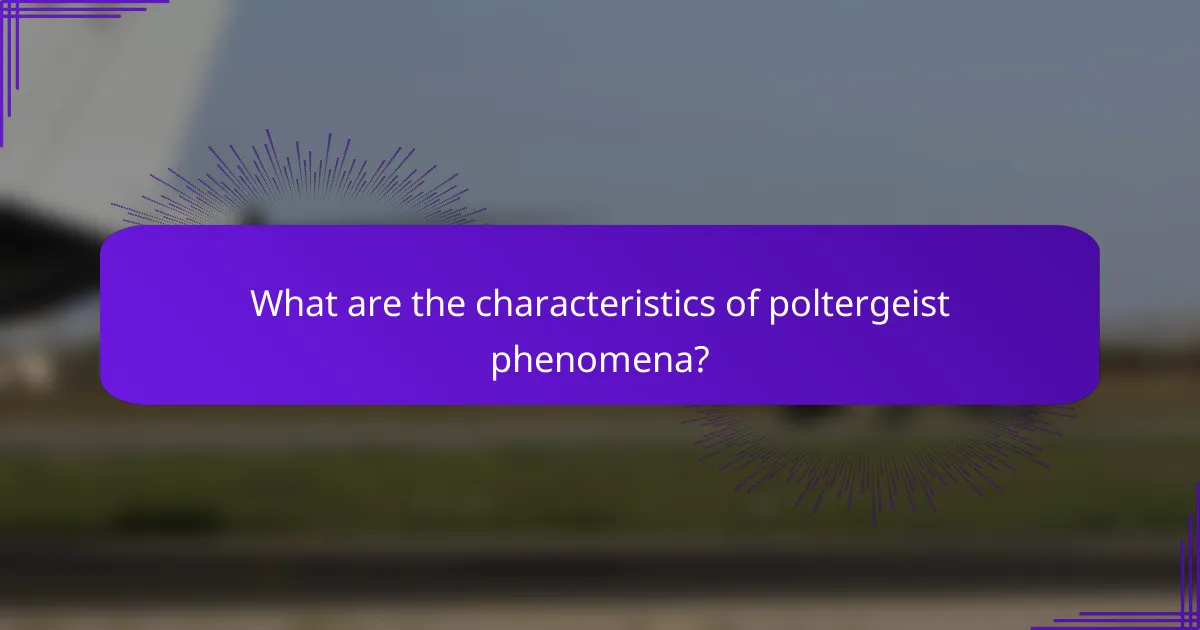
What are the characteristics of poltergeist phenomena?
Poltergeist phenomena are characterized by unexplained physical disturbances, often attributed to mischievous spirits or energies. These manifestations typically involve movement of objects, unusual noises, and sometimes even physical sensations experienced by individuals in the vicinity.
Manifestation patterns
Poltergeist activity often presents in distinct patterns, including the sudden movement of objects, loud noises, and the appearance of unexplained phenomena like lights flickering. These manifestations can occur sporadically or in clusters, with some reports indicating that activity may intensify during emotional events or stress within a household.
Common examples of manifestation patterns include items being thrown across a room, doors slamming without a visible cause, and strange sounds such as knocking or tapping. The intensity and frequency of these occurrences can vary widely, leading to a range of experiences for those affected.
Duration of activity
The duration of poltergeist activity can be quite variable, often lasting from a few days to several months. Some cases may experience intermittent activity over years, while others may have a sudden onset followed by a quick cessation. This unpredictability can make it challenging to study and understand the phenomena.
In many instances, poltergeist activity appears to correlate with specific life events, such as adolescence or family stress, suggesting that emotional states may play a role in the duration and intensity of the disturbances. Observers often report that once the triggering factors diminish, the poltergeist activity tends to subside as well.

